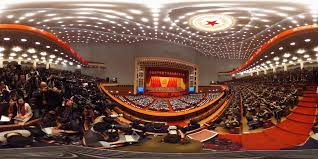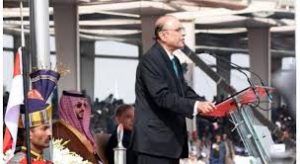China’s “two sessions” offer new impetus, inspirations for global development

Beijing: In the past few days, China’s annual “two sessions” have attracted much global attention, with the international community watching closely where the world’s second largest economy is heading and what impetus it will generate for global development.
Inspired by China’s prominent achievements amid the pandemic and heartened by the country’s new development blueprint, observers worldwide believe China’s resolution to achieve modernization through high-quality development will definitely promote world prosperity.
During the annual sessions of the country’s top legislature and political advisory body, China reviewed its achievements and experience in coordinating epidemic control and economic development, which observers believe will inject confidence into the global fight against the deadly pathogen.
The country became the only major economy that registered positive growth last year, with its gross domestic product (GDP) increasing by 2.3 percent year on year to cross the 100-trillion-yuan (about 15.40 trillion U.S. dollars) threshold, while its imports and exports of goods expanded 1.9 percent.
People work at a workshop of Harbin Dongan Automotive Engine Manufacturing Co., Ltd. in northeast China’s Heilongjiang Province, Feb. 25, 2021. (Xinhua/Wang Jianwei)
In 2020, all of China’s nearly 100 million impoverished rural residents living below the current poverty line cast off poverty after eight years’ efforts.
China has demonstrated its ability to cope with unexpected challenges facing the world, said Andrei Vinogradov, head of the Center for Political Studies and Forecasting at the Institute of Far Eastern Studies under the Russian Academy of Sciences.
“China’s victory in eradicating absolute poverty is a major achievement … This experience is of global importance,” Vinogradov said.
China has avoided the “trap” of a dilemma between safeguarding health and beefing up the economy, and its strategy “has resulted in overcoming the health crisis inside China and at the same time protecting its economy,” said Pelagia Karpathiotaki, a Beijing-based researcher at China’s University of International Business and Economics.
Praising the Chinese people’s dynamism in fighting the pandemic, Bernard Dewit, chairman of Belgian-Chinese Chamber of Commerce, said “this can be a model for the rest of the world, because despite being severely hit by the pandemic, they could overcome it and even go further with growth, with improving the situation of its population.”
China has displayed the “generosity spirit” of international cooperation in its global anti-virus efforts, said Munir Akram, president of the UN Economic and Social Council.
During the “two sessions,” China set its goals for 2021 and adopted the country’s development blueprint for the next five to 15 years, which, with an emphasis on high-quality development, are expected to bring fresh opportunities to the pandemic-battered world.
China aims to expand its GDP by over 6 percent year on year in 2021, with more efforts on reform, innovation and high-quality development, according to the government work report.
The growth target shows “the determination and confidence of the Chinese government to promote sustained economic recovery to the world, and China will continue to boost the world economy,” said Tursunali Kuziev, a professor at Uzbek University of Journalism and Mass Communications.
In the 14th Five-Year Plan (2021-2025) period and beyond, high-quality development will remain the theme for China’s economic and social development, and it concerns the overall situation of the country’s socialist modernization drive.
At the same time, the country will implement opening-up policies in a wider scope and broader areas and at a deeper level, and better participate in international economic cooperation.
The goals for 2021 and the blueprint for economic and social development over the next five years “are impressive,” said Jeffrey Sachs, an economics professor at Columbia University and a senior UN advisor.
“They aim for sustainable development, based on reduced pollution, resource efficiency, scientific and technological advance, expanded education, and improved quality of life,” Sachs said.
Visitors learn about an automatic aircraft on display at an exhibition during the “China 5G + Industrial Internet Conference” in Wuhan, central China’s Hubei Province, Nov. 19, 2020. (Xinhua/Cheng Min)
According to the blueprint for its development in the next five to 15 years, China will accelerate forging a new development paradigm of “dual circulation,” in which domestic and overseas markets reinforce each other with the domestic market as the mainstay.
“‘Dual circulation’ puts a parallel emphasis both on domestic and international circulation. A high-level opening-up certainly serves this end, brings win-win outcomes both for Chinese and multinational companies,” said Jochen Goller, chief of BMW Group Region China.
For observers, the annual “two sessions” provide them with an opportunity to decode China’s enormous successes and better understand its democracy.
China has always put the people first during its development, increasing their benefits, ensuring that the people are their own masters and supporting development in an all-round way.
From the massive poverty alleviation campaign and the handling of the pandemic, to the development blueprint and goals that aim to meet people’s aspiration for a better life, China has shown that its modernization involves not only a remarkable increase in economic production capacity, but also comprehensive targets to improve people’s well-being.
China’s poverty alleviation campaign is “the work of a nation committed to its people,” according to Stephen Perry, chairman of Britain’s 48 Group Club.
Describing China’s response to the pandemic as “first class,” Perry said no other country could get thousands of doctors and nurses to Hubei, once the hardest-hit province in China, within days.
“As soon as the Chinese government knew about the severity of this epidemic, they moved the priority to saving lives,” Perry said.
Meanwhile, the agendas of the “two sessions” have demonstrated that China’s democracy features an extensive collection of public suggestions, thorough discussions and a gradual formation of consensuses.
Sourabh Gupta, a senior fellow at the Washington-based Institute for China-America Studies, said that the “two sessions” present a window on how China efficiently builds consensuses for its development strategies and goals.
“I think the consensus-building process is just as hard, but it’s more efficiently conducted in China,” Gupta said.
“You have so many delegates from the provinces and from local levels at the ‘two sessions’ showing … how broad and wide that consensus is,” Gupta said.





